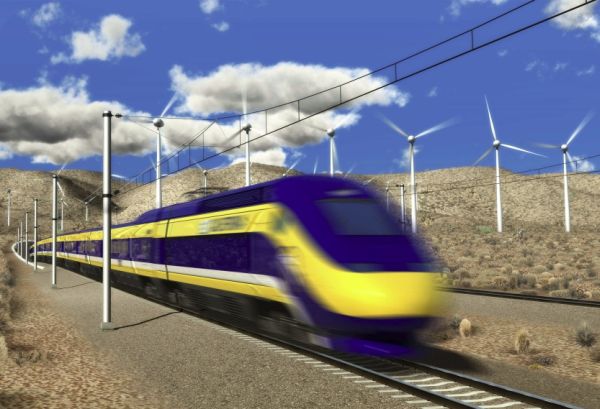The Future Of Rail: Sustainable Travel With Wind-Powered Trains

Table of Contents
The Technological Feasibility of Wind-Powered Trains
Utilizing Wind Turbines for Power Generation
The core concept behind wind-powered trains involves integrating wind turbines into the train's design or alongside the railway tracks. Several approaches are being explored:
- Onboard Turbines: Smaller, lightweight wind turbines could be mounted on the train itself, capturing wind energy during travel. This approach requires efficient energy storage solutions to manage fluctuations in wind speed.
- Alongside-Track Turbines: Larger, more powerful wind turbines could be strategically positioned along railway lines, generating electricity that's fed into the train's power system via overhead lines or inductive charging. This offers the potential for greater energy generation but necessitates significant infrastructural investment.
Energy generated by these turbines needs to be stored efficiently. Advanced energy storage systems like:
- High-capacity batteries: These offer a readily available power source, but their weight and lifespan are limiting factors.
- Flywheel energy storage systems: These store energy kinetically, offering rapid charge and discharge capabilities, but are currently less energy-dense than batteries.
Research and development in this field are ongoing. Several universities and companies are actively investigating various designs and technologies, paving the way for more efficient and practical solutions.
- Examples of current prototype designs or pilot projects: While large-scale deployments are still in the future, several smaller-scale prototypes and experimental projects are underway in various countries, demonstrating the growing interest and investment in this innovative technology.
Overcoming Technological Hurdles
Despite the exciting potential, significant challenges remain:
- Energy storage capacity: Storing enough energy to power a train over long distances, especially during periods of low wind speed, requires significant advancements in battery or flywheel technology.
- Weight limitations: Adding wind turbines and energy storage systems increases the train's overall weight, potentially impacting speed and efficiency.
- Reliability in varying wind conditions: Wind speed is unpredictable, meaning a reliable backup power source (like a hybrid system using traditional electricity) is essential.
Solutions being explored include:
-
Hybrid power systems: Combining wind energy with existing diesel or electric power sources ensures a constant supply of power, mitigating the risk of energy shortages during low-wind conditions. This offers a more practical approach in the near term.
-
Specific engineering challenges and potential solutions: Ongoing research focuses on developing lighter, more efficient turbines, improving energy storage density and lifespan, and implementing intelligent control systems to optimize energy use based on real-time wind conditions.
Environmental Benefits of Wind-Powered Trains
Reducing Carbon Footprint
Wind-powered trains offer a significantly reduced carbon footprint compared to traditional transportation methods. By replacing fossil fuels with a renewable energy source, we can drastically minimize greenhouse gas emissions:
- Comparison of carbon emissions for different rail transport methods: Studies show that wind-powered trains have the potential to reduce CO2 emissions by up to 90% compared to diesel trains and significantly reduce emissions compared to electric trains powered by fossil fuel-based electricity.
This reduction in greenhouse gas emissions has a considerable positive impact on air quality, particularly in densely populated areas served by railway lines.
Promoting Sustainable Tourism
Wind-powered trains offer a compelling option for eco-conscious travelers, contributing to the growing trend of sustainable tourism:
- Benefits for tourism: The "green" aspect of wind-powered trains can be a significant selling point, attracting environmentally aware tourists and boosting the appeal of rail travel.
- Marketing opportunities: Rail companies can leverage the sustainability aspect of wind-powered trains in their marketing campaigns, attracting a new segment of environmentally conscious customers.
Economic and Infrastructure Considerations
Initial Investment Costs and Long-Term Savings
The initial investment required to develop and implement wind-powered train technology is substantial. This includes:
- Breakdown of costs (research, development, infrastructure): Costs cover research and development of new technologies, manufacturing of wind turbines and energy storage systems, and modifications to existing railway infrastructure.
However, the long-term cost savings from reduced fuel consumption can significantly outweigh these initial investments.
Infrastructure Requirements and Integration
Adapting existing railway infrastructure to accommodate wind-powered trains necessitates careful planning and significant investment:
- Infrastructure upgrades: This might involve upgrading overhead power lines, installing new charging stations for onboard batteries, or constructing alongside-track wind turbine farms.
- Land acquisition needs: The installation of alongside-track turbines requires securing land adjacent to railway lines, which might necessitate negotiations with landowners and environmental impact assessments.
Embracing the Future of Sustainable Rail with Wind Power
Wind-powered trains offer a compelling vision for a greener future in transportation. The significant environmental benefits, coupled with the potential for long-term economic savings and technological advancements, make this a worthwhile area of investment. We must continue to invest in research and development to overcome remaining technological hurdles and make this innovative solution a reality. Join the movement towards a greener future with wind-powered trains! Discover how wind-powered trains can transform sustainable travel and contribute to a more environmentally responsible future.

Featured Posts
-
 Reform Party Under Fire Farages Savile Reference Causes Uproar
May 03, 2025
Reform Party Under Fire Farages Savile Reference Causes Uproar
May 03, 2025 -
 I Diavrosi Toy Kratoys Meso Tis Poleodomikis Diafthoras Kai I Anagkaia Metarrythmisi
May 03, 2025
I Diavrosi Toy Kratoys Meso Tis Poleodomikis Diafthoras Kai I Anagkaia Metarrythmisi
May 03, 2025 -
 Lotto 6aus49 Ergebnis 19 April 2025 Alle Gewinnzahlen Im Ueberblick
May 03, 2025
Lotto 6aus49 Ergebnis 19 April 2025 Alle Gewinnzahlen Im Ueberblick
May 03, 2025 -
 Where To Find The Latest Lotto Lotto Plus 1 And Lotto Plus 2 Results
May 03, 2025
Where To Find The Latest Lotto Lotto Plus 1 And Lotto Plus 2 Results
May 03, 2025 -
 Wildfires And Wagers Exploring The Los Angeles Betting Scene
May 03, 2025
Wildfires And Wagers Exploring The Los Angeles Betting Scene
May 03, 2025
